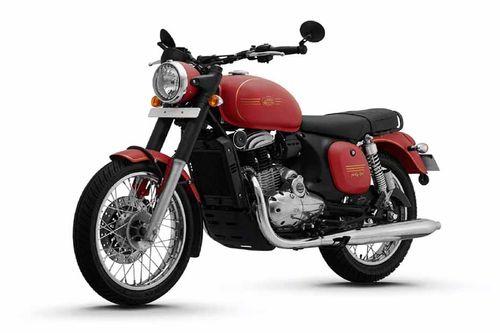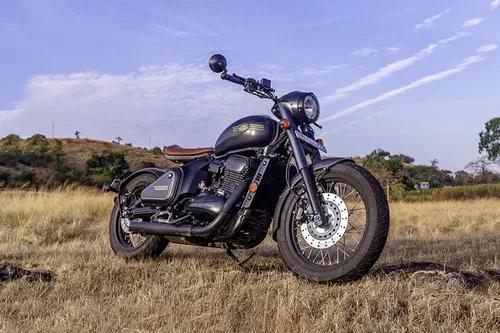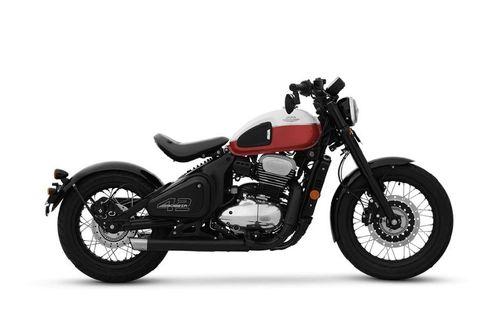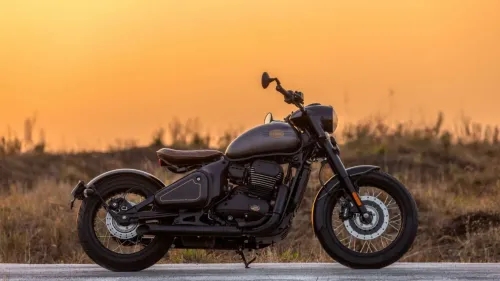About Jawa Bikes
Jawa Motorcycles traces its origins to the visionary Czech engineer František Janeček. In 1929, Janeček purchased the motorcycle division of the German company Wanderer, which was struggling financially. Combining the first two letters of Janeček and Wanderer, the brand Jawa was born. The company’s first product, the Jawa 500 OHV, was introduced in 1929. Though not an immediate success, it showcased Janeček’s commitment to quality engineering.
1930s: Rise to Prominence
In the early 1930s, Jawa shifted its focus to producing lightweight and affordable motorcycles to meet growing market demands during the Great Depression. The introduction of the Jawa 175 Villiers in 1932, powered by a licensed Villiers engine, marked a turning point. This model became widely popular for its simplicity and reliability, earning Jawa a reputation as a dependable motorcycle manufacturer.
By the late 1930s, Jawa introduced models like the Jawa 250 Duplex Blok, which featured advanced engineering and innovative design. The company also began exporting motorcycles, establishing a global footprint.
1940s: Surviving World War II
World War II disrupted Jawa's operations, as the German occupation of Czechoslovakia forced the company to pivot toward manufacturing for the war effort. Despite these challenges, Jawa engineers secretly worked on new designs, including the Jawa Perak. Post-war, the Perak became one of Jawa’s most iconic motorcycles, symbolizing resilience and innovation. Launched in 1946, it featured a sleek design, telescopic front forks, and a robust two-stroke engine.
1950s: Expansion and Global Recognition
The 1950s saw Jawa emerge as a leading motorcycle manufacturer in Europe. The company introduced the Jawa 353 Kyvacka, a highly popular model known for its swinging arm rear suspension. Jawa’s commitment to innovation also extended to motorsport, as the brand began participating in international motorcycle racing events.
During this era, Jawa started exporting motorcycles to markets in Asia, Africa, and South America. Its robust, simple designs and reliable performance made Jawa a favorite in countries like India, where the brand would later gain a cult following.
1960s: Jawa in India and the Birth of Ideal Jawa
In 1960, Jawa partnered with Ideal Jawa, a Mysore-based company, to assemble and later manufacture Jawa motorcycles in India. The first Jawa motorcycles rolled out in India were the Jawa 250 and Jawa 350, which quickly gained a loyal fan base. Known for their durability and ease of maintenance, these models became the choice of Indian riders seeking reliable two-wheelers.
Globally, Jawa introduced the Jawa Californian in the 1960s, a model designed specifically for the American market. The brand also gained recognition in motocross and speedway racing, with Jawa-built bikes achieving significant success.
1970s: Transition to Yezdi in India
By the early 1970s, Jawa’s operations in India shifted toward a new brand identity: Yezdi. Ideal Jawa rebranded its motorcycles under the Yezdi name, with models like the Yezdi Roadking and Yezdi Classic retaining the same Jawa DNA of ruggedness and reliability. These motorcycles became symbols of adventure and freedom for generations of Indian riders.
Meanwhile, Jawa in Czechoslovakia continued its operations, focusing on both commuter motorcycles and high-performance racing bikes. The company introduced new models like the Jawa 350 Type 634, which was popular in Eastern Europe and beyond.
1980s: Decline in Popularity
The 1980s brought challenges for Jawa as the motorcycle market became increasingly competitive. Japanese manufacturers like Honda, Yamaha, and Suzuki began dominating the global market with advanced, fuel-efficient motorcycles. Jawa’s two-stroke engines and older designs began to lose their appeal.
In India, Yezdi motorcycles also faced similar competition, leading to a decline in sales. By the mid-1990s, Ideal Jawa ceased operations in India, marking the end of an era.
1990s–2000s: A Period of Dormancy
Globally, Jawa’s presence diminished significantly during the late 20th century. However, the brand maintained a niche following, particularly in Eastern Europe, where its motorcycles were still valued for their ruggedness. In the absence of new models, Jawa motorcycles from the mid-20th century became sought-after collectibles.
2010s: Jawa’s Revival by Mahindra Group
In 2018, Jawa made a remarkable comeback under the stewardship of Classic Legends, a subsidiary of India’s Mahindra Group. Recognizing the enduring love for Jawa motorcycles in India, Classic Legends acquired the rights to the Jawa brand and reintroduced it with modern engineering while retaining the classic design ethos.
The revival began with the launch of three models:
Jawa (Classic): A retro-styled motorcycle paying homage to the original Jawa 250.
Jawa Forty Two: A modern take on the classic design with contemporary styling.
Jawa Perak: A factory-custom bobber motorcycle, showcasing Jawa’s innovation.
These motorcycles were powered by a newly developed 293cc and 334cc liquid-cooled, single-cylinder engines that met modern emission norms while delivering a nostalgic riding experience.
2020s: Strengthening the Legacy
The reintroduced Jawa motorcycles received an overwhelmingly positive response, particularly in India, where the brand still had a cult following. Jawa expanded its product lineup and focused on refining its motorcycles to meet customer expectations.
Jawa also began exploring electric mobility, aligning with global trends. The company teased plans for electric motorcycles that retain the classic styling for which Jawa is known.
In addition to new products, Jawa motorcycles became prominent in custom culture, with riders customizing their bikes to create unique expressions of style and performance.
Jawa’s Racing Heritage
Jawa’s contribution to motorsport, especially in speedway and motocross racing, is a significant part of its legacy. Jawa speedway bikes, powered by specialized single-cylinder engines, achieved great success in Europe during the mid-20th century.
Legacy and Global Appeal
Jawa Motorcycles remains a symbol of timeless design, reliability, and adventure. Its resurgence in the 21st century underscores the enduring appeal of the brand, which continues to blend retro aesthetics with modern technology. Jawa’s ability to evoke nostalgia while catering to contemporary riders ensures its place as an iconic motorcycle brand. With its roots firmly planted in history and a vision for the future, Jawa Motorcycles is poised to inspire generations of riders around the world.
Brand USP
Jawa bikes lie in their seamless blend of retro charm and modern performance. These motorcycles offer a nostalgic design reminiscent of the original Jawa models from the mid-20th century, appealing to riders who value vintage aesthetics.
Classic Retro Design: Jawa motorcycles are renowned for their timeless, retro design that evokes a sense of nostalgia. The classic styling, combined with modern engineering, appeals to both vintage motorcycle enthusiasts and new-age riders looking for a unique aesthetic.
Build Quality: Jawa bikes are known for their robust build quality and durability. The solid construction ensures that these motorcycles can withstand rough terrains and long rides, making them reliable companions for adventure seekers.
Powerful Performance: Equipped with powerful engines, Jawa motorcycles deliver impressive performance. The blend of torque and power ensures a thrilling riding experience, whether on city roads or highways.
Heritage and Legacy: They has a rich heritage and a storied legacy that dates back to the early 20th century. This historical significance adds to the brand's allure, making it a symbol of enduring quality and craftsmanship.
Modern Technology: Despite their retro appearance, Jawa bikes incorporate modern technology and features. This includes advanced braking systems, fuel injection, and efficient engines that meet contemporary emission standards, providing a seamless blend of old-world charm and modern functionality.
Community and Culture: They have cultivated a strong community of riders and enthusiasts. This sense of belonging and shared passion for the brand enhances the ownership experience, fostering a culture of camaraderie and pride among Jawa owners.
Customization Options: They offers a range of customization options, allowing riders to personalize their bikes to reflect their individual style. This flexibility in customization adds to the appeal, making each Jawa motorcycle unique to its owner.
Brand Latest Updates 2024
- Ownership Reviews: The Jawa 350 has been receiving positive reviews from owners, highlighting its blend of classic design and modern performance. Riders appreciate its robust build, comfortable suspension, and the nostalgic appeal it brings.
- Updates: The Jawa 350 Blue color was showcased, adding a striking new option to the existing palette
- Sales Performance: Jawa recorded a sales of 4180 units in Oct 2024, with a 50.58% growth in comparison to the previous year.
- New Lunches: Jawa launched its 42 FJ on Sep 3, 2024. Apart from these, we have seen 1 launch in the past 3 months.
Jawa Bike Series
The Jawa 42 comes in multiple variants, each offering different features, colors, and pricing. Some of the notable variants include:
- Jawa 42 Single Channel ABS
- Jawa 42 Dual Channel ABS
- Jawa 42 Bobber
Jawa Bike Price (ex- showroom)
Model | Price |
Jawa 42 | ₹1.73 Lakh - ₹1.98 Lakh |
Jawa 42 Bobber | ₹2.12 Lakh - ₹2.29 Lakh |
Jawa 42 FJ | ₹1.99 Lakh - ₹2.20 Lakh |
Jawa 350 | ₹1.98 Lakh - ₹2.14 Lakh |
Jawa Perak | ₹2.13 Lakh |
Jawa Dealers in India
Jawa’s dealership network spans 300+ outlets in 250 plus cities across India, ensuring accessibility for customers. Each dealership is designed to provide a premium buying experience while reflecting the brand’s retro appeal.
Locate the nearest Jawa dealer using their official dealer locator tool.
Jawa Service Centres
Jawa motorcycles are supported by a growing network of around 180 service centres in 155 plus cities across the country, ensuring a smooth and reliable ownership experience.
Jawa Toll-Free Number
You can connect to Honda’s Customer Care for inquiries, complaints, or service requests through a Toll-Free Number: 1800-103-2342
How to get a Jawa bike loan?
To avail of a loan for Jawa bikes, you can visit a Jawa dealership, where they offer financing schemes through partnered institutions. The loan application process involves checking your eligibility based on different factors. Loan amounts are typically disbursed quickly, with flexible repayment terms ranging from 12 to 60 months. Some schemes offer zero down payment or low-interest rates, and EMI options are available to suit different budgets. Be sure to compare the available offers at the dealership or online to find the best financing plan for your needs.
Why choose CarBike360?
CarBike360 is a trusted platform for researching, comparing, and purchasing vehicles, including Bikes bikes. It offers an easy-to-use interface, detailed specifications, reviews, and the latest updates on bike prices and availability in India. With CarBike360, you can access expert advice, check real-time prices, and make informed decisions.
















































